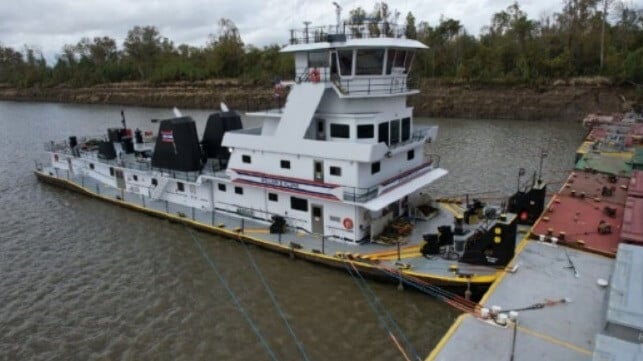NTSB: Fatigued Pilot Distracted by Cell Phone Caused Towboat Collision

The National Transportation Safety Board is yet again highlighting an example of distracted navigation through the use of a personal cellphone and other non-operational tasks, which it says contributed to the collision of a towboat on the Lower Mississippi, causing more than $800,000 in damages. Also contributing to the incident, the NTSB reports fatigue and a lack of familiarity with the vessel that was being navigated.
A pilot joined the crew of the towboat William B Klunk on April 17, 2024, at a position near Baton Rouge, Louisiana, along the Lower Mississippi River as the vessel was pushing 22 laden barges from Illinois to Louisiana. There was a crew of 10 aboard, and as is typical, the captain and pilot were splitting the watches and navigation duties.
During the pre-departure planning session, the pilot admitted he had driven overnight 150 miles to join the vessel. He denied fatigue and said he had napped in his car, although the NTSB report on the incident notes that individuals are often a poor judge of their own fatigue. The captain also told investigators he was not concerned about the pilot being fatigued. He warned the pilot that the vessel’s steering was slower to respond than he was familiar with before they got underway. They departed with the pilot navigating and the captain off the bridge.
The vessel was underway for about 1.5 hours, traveling at around 9 knots, and had just completed passing a vessel traveling in the opposite direction when it left the channel and collided with moored barges. Thirteen of the barges in the tow broke away, and three of the moored barges also broke away. There was one minor injury and a total of $810,000 in damages.
During the investigation, the pilot told the NTSB that there had been a steering failure on the towboat. The investigation, however, found no issues that would indicate a steering failure. They concluded that the steering system may not have responded as quickly as the pilot expected, leading him to believe that the vessel lost steering.
Interviews with other vessels showed the pilot had not been responding to radio calls, and the vessel was navigating inconsistently. The NTSB’s investigation found the pilot “engaged in nonoperational, secondary tasks, including taking an administrative call from the company’s safety officer, making a personal phone call on his cell phone, and sending text messages.”
In the six minutes leading up to the collision, the NTSB reports the pilot did not make any rudder or throttle adjustments as the tow moved toward the fleeting area where it hit the moored barges. The onboard image recorded system footage showed the pilot using his personal cell phone and not monitoring the tow’s position 40 seconds before the collision.
“Use of cell phones, including company cell phones (particularly for nonoperational conversations), should never interfere with a watchstander’s primary task to safely navigate a vessel and maintain a proper lookout,” the report said. “To reduce the risk of cell phone distraction, operating companies should establish protocols regarding both personal and work-related cell phone use, and vessel personnel should understand the importance in following them.”
Investigators also determined that the pilot’s fatigue due to limited sleep the night before contributed to the collision. The pilot received about four hours of continuous sleep in the 36 hours before the collision. The pilot’s fatigue was due to his being up nearly 18 hours at the time of the collision.
It also notes that due to his unfamiliarity with the systems on the bridge, the pilot manipulated the wheelhouse steering control panel. They found he inadvertently turned the steering pumps off before the captain reached the bridge and took the helm after the collision.
The company’s safety officer is also cited as he made a call to the towboat to discuss a non-navigation issue while the pilot was steering the vessel. The call lasted about 15 minutes, the NTSB reports, during which the pilot was told he was being written up for a policy violation (he was wearing shorts, which was against company policy). The NTSB says the safety officer should not have conducted the call when he determined the pilot was navigating, and the lead deckhand later told the NTSB he was on the bridge and the pilot seemed “flustered” from the phone call.
